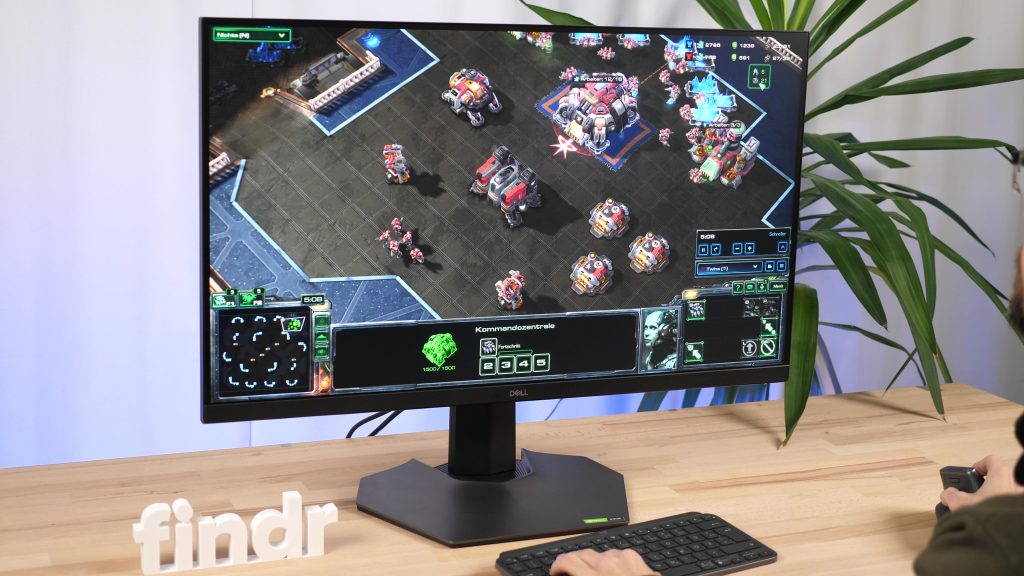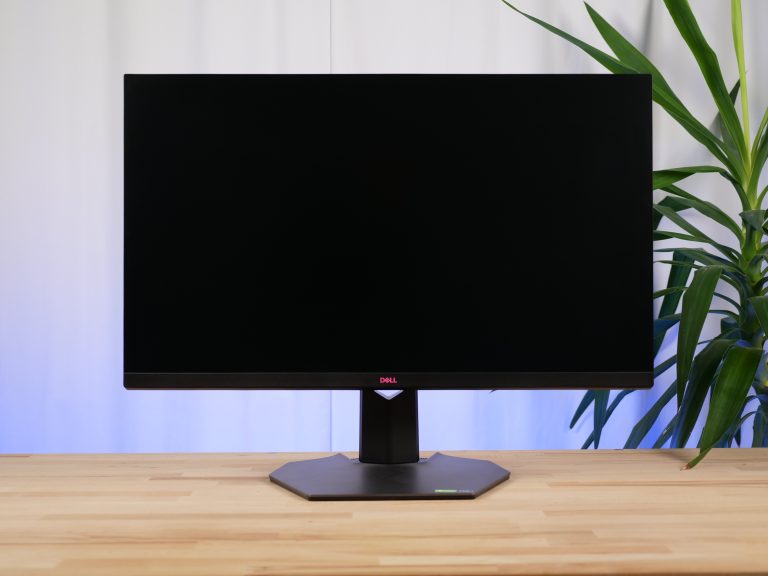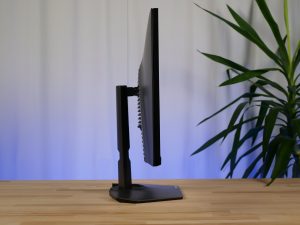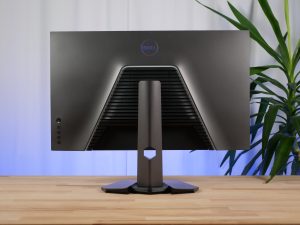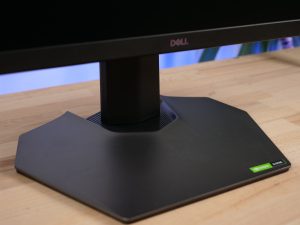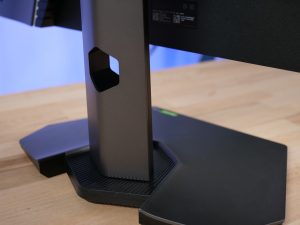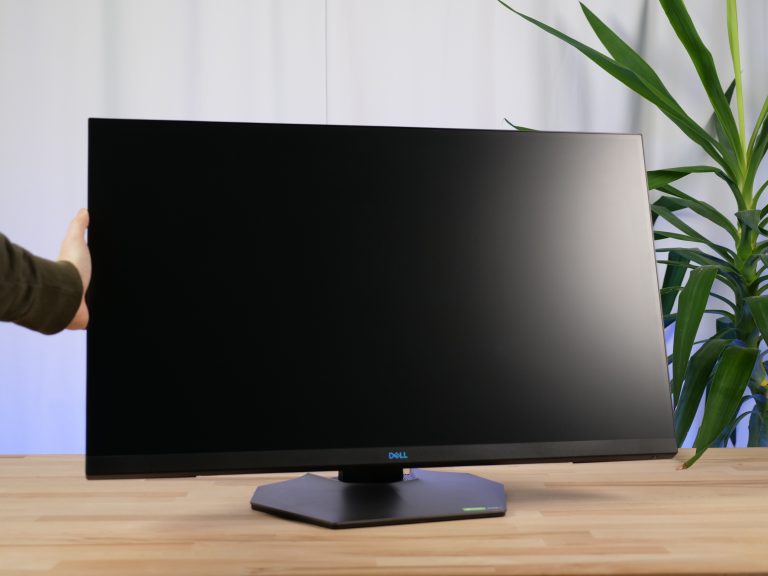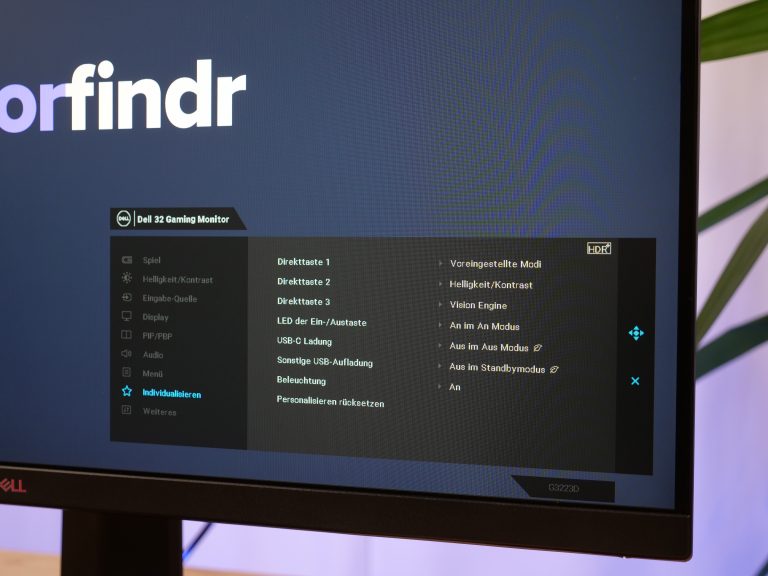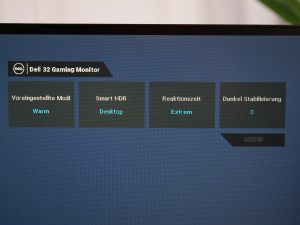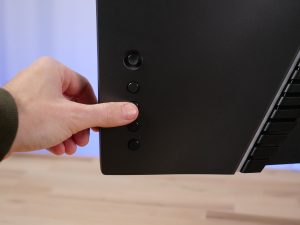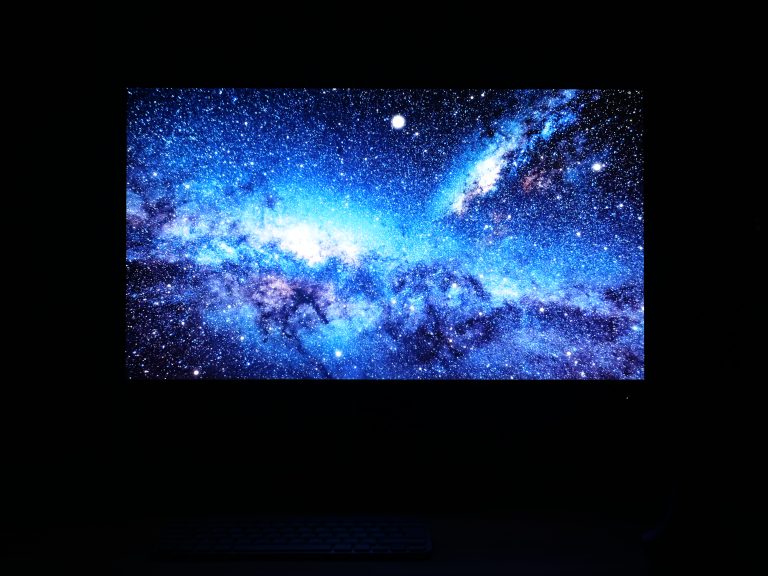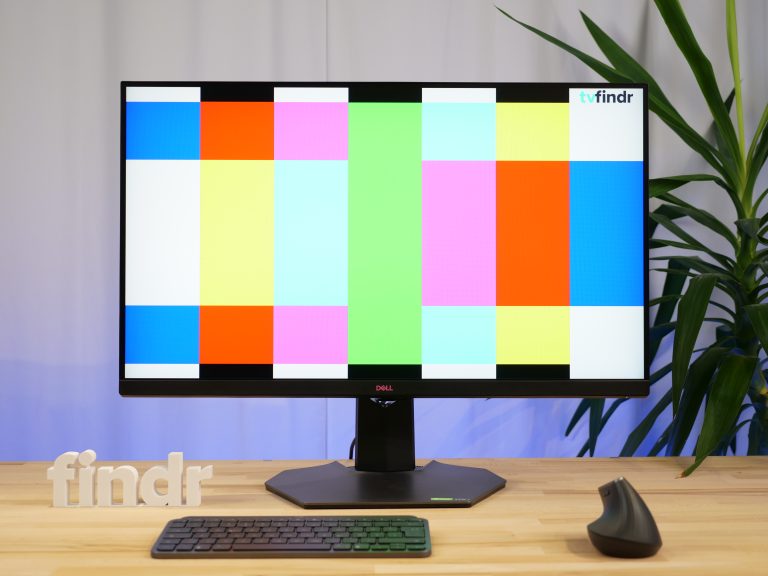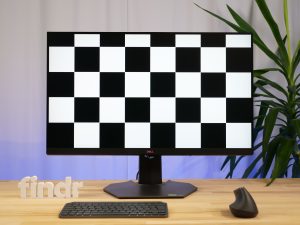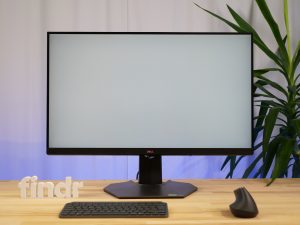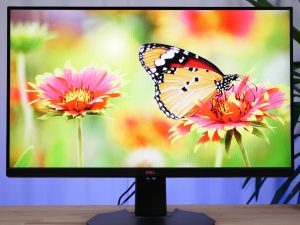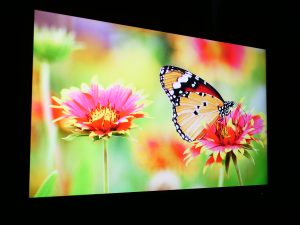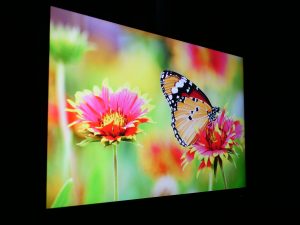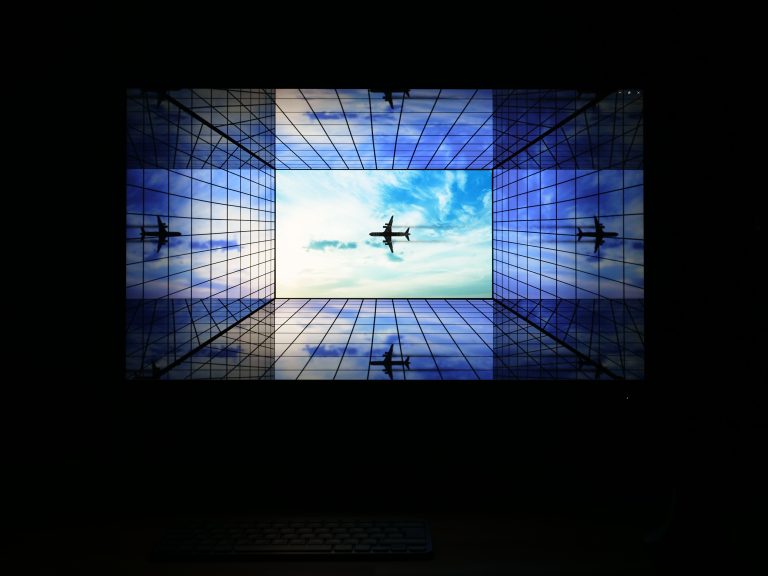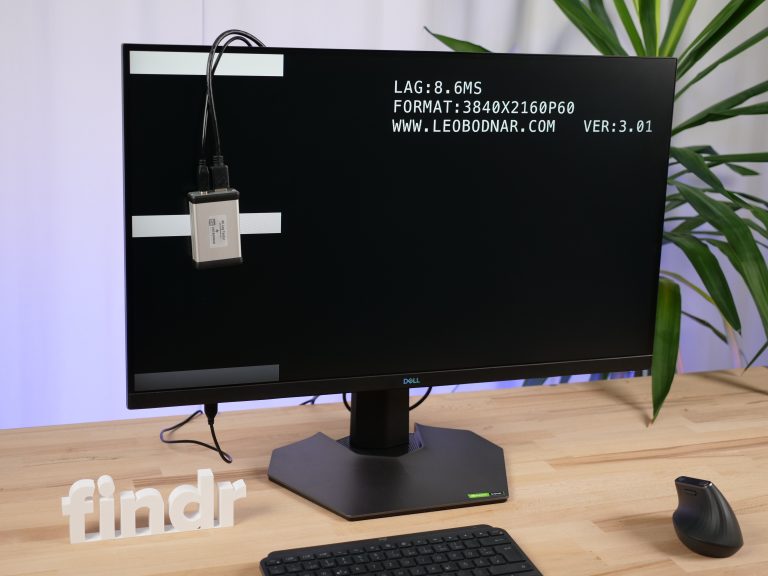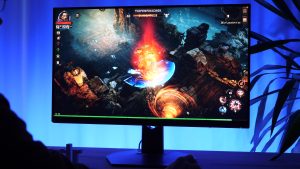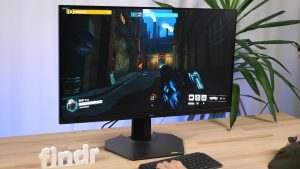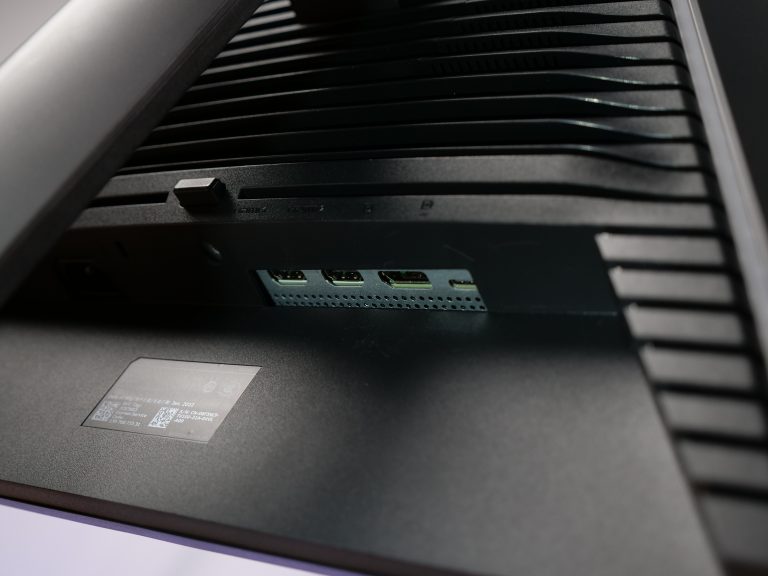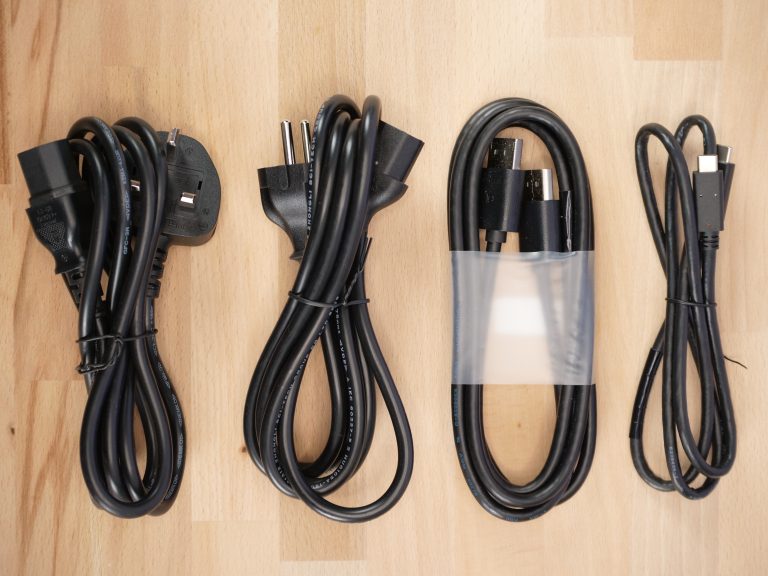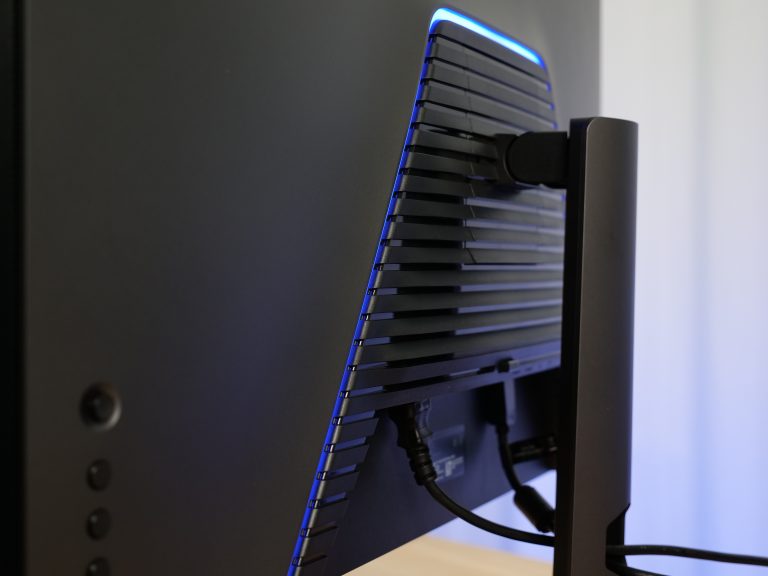Dell G3223D - Great colors and high frame rate
If you are looking for a large gaming monitor with wide color gamut coverage, the Dell G3223D is definitely worth a stop. The 32-inch model has a fast response time and scores particularly well in terms of color reproduction. However, the display is not a luminance monster with a measured 461 nits, but it still shows brightness peaks decently.
The QHD resolution of the panel is not a real disadvantage in terms of quality and gives your computer more room to exploit the high frame rate of up to 165 hertz. Especially friends of fast genres like first-person shooters and racing simulations will benefit from this. The contrast is rather average, but it hardly had a significant impact during our test.
Small things like the missing pivot function or a bit more flexibility in terms of ergonomics just slightly tarnish the really good overall impression. The G3223D is not a real bargain at currently around 400 Euros, but the purchase price is still absolutely within the target range for the offered performance.
- Beautiful color display
- Large QHD screen
- High frame rate for gaming
- Nimble response time
- Good usability
- Stable stand
- Average contrast
- Without daisy chain
- Pivot feature missing
- No internal speakers integrated
Your alternatives on the Dell G3223D
If you can do without some ergonomics and accept a slight drop in refresh rate, you will get a much cheaper QHD monitor of the same size with the Lenovo G32qc-10. The Gigabyte G32QC offers a curved display for slightly less money. However, this gaming screen is not quite on the same level as the Dell G3223D in terms of specifications.
Proper manufacturing quality in the Dell G3223D
The little brother of the Dell G3223Q – which we tested before – can be easily transformed from packed to ready for use in a short time. This is ensured by the quickly assembled stand, which we already know from the Q model.
The G3223D has many similarities to the much more expensive 4K model. Starting with the color scheme and the design up to the menu navigation. Fortunately, the D series also adopts many features of the higher-priced Q variant. We could not determine any potential cutbacks that Dell made in this point with our test device.
In plain language, this means: A well-made plastic dress in anthracite with sufficient stability due to the massive stand, with an internal metal construction and a simple cable gland on the back encases the almost 32-inch 16:9 flat display.
Therefore, the model does not necessarily look like a true gaming monitor when viewed from the front and could easily pass for a “simple” office screen. On the back, the impression is a bit fiercer.
Despite having nominally the same screen size, the QHD version is over a centimeter wider than the Q version and weighs over 3.5 kilograms more.
Dell G3223D - Ergonomic leeway is alright
The ergonomic settings are already on a good level ex-works. Thus, you can adjust the screen of Dell’s G3223D to your sitting position with quite enough leeway. This allows you to adjust the height by a total of 10 centimeters, swivel it by up to 30 degrees in any direction, and tilt it by a radius of 26 degrees.
Difficulties might arise if your desk is comparatively low or you want to adapt the G3223D as an additional monitor to an already existing one. In this case, you always have the option of using external solutions like a large swivel arm.
Depending on the mount, you can also retrofit the monitor with a pivot feature, which you would otherwise miss out on. Mounting is done via the built-in VESA MIS-D standard.
Quick and easy navigation
You can operate the device via a so-called on-screen display, which you access using a 5-way joystick on the right bottom side. You can quickly and easily navigate around a clearly arranged and intuitive menu tree.
It is worth mentioning that three of the four keys below the control lever can be assigned individually. This allows you to open frequently used settings with a single keystroke or activate features directly.
The Dell G3223D offers a surprisingly good color reproduction
In contrast to its big brother, the Dell G3223D features an IPS panel with QHD screening, which is the 2K resolution standard with 2560 x 1440 pixels. You can expect up to 165 frames per second if you have the appropriate hardware.
Unlike high-resolution 4K monitors with 120 hertz and more, this hardware combination achieves very specific advantages that make QHD monitors so popular.
Although the lower pixel count reduces the effective pixel density on the panel, the difference to a native UHD resolution is comparatively small in contrast to the leap from Full HD.
Thus, corresponding image contents hardly have barley any noticeable visual drawbacks for the viewer. As a result, the G3223D’s existing 93 ppi are still sufficient to achieve a suitably high image sharpness and reproduce outlines cleanly.
As a consequence, the data rate is considerably lower and allows the maximum refresh rate to be raised even when the older HDMI 2.0 standard is used. This makes the best possible use of the available bandwidth. An additional advantage: High frame rates are easier to achieve because performance buffers are freed up. This ensures a smoother gaming experience and a better overall view on the screen.
Overall, the picture makes a clean impression. Colors look balanced and clear. The display covers sRGB completely and Adobe RGB to 87%. DCI-P3 is covered by 95%, which means that the Dell is also quite suitable for image and video editing.
In dark scenes, weaknesses show up from time to time, which can be explained by the rather average contrast. The gray uniformity performs surprisingly well. Except for small areas in the corners, which are slightly darker, the display on our test device is very even.
In addition to a good viewing-angle stability, the matte screen surface and the panel’s solid luminance ensure that light sources directly hitting the screen are only slightly recognizable. Due to the support of the HDR400 standard, highlights may not be impressively bright on your retina, but highlights are still reproduced well.
Quick switching time
The extremely agile response time of just over 3 milliseconds effectively minimizes trailing shadows when navigating with the mouse or moving boxes on the desktop. Contours thus remain clean for the most part.
Up to 165 frames per second round off the performance picture and ensure a pleasantly smooth presentation on the QHD screen even with video material or real-time content.
Made for first-person shooters
Although you won’t find a latest HDMI 2.1 port on the Dell G3223D, you don’t have to worry about that. As we already mentioned in the picture quality section, the gaming monitor gets by without any major drawbacks due to its specifications. On one hand, this model is more hardware-friendly, but on the other hand, it offers the possibility to fire the panel with up to 165 FPS.
Especially in first-person shooters and racing games, this in combination with the low response time ensures a good result, since you often have to act quickly there and need a good overview for that. You get AMD’s FreeSync Premium Pro and G-Sync compatibility for the frame rate synchronization between graphics card and display.
Via console mode, you can adapt the G3223D specifically to the parameters of your PlayStation or Xbox and thus use HDR and VRR support with a resolution of up to 2K in addition to frame rates of up to 120 hertz on Xbox Series X|S and PlayStation 5. The input delay of just over 8 milliseconds is also pleasantly low.
USB-C instead of HDMI 2.1
Besides two HDMI 2.0 ports, Dell provides a DisplayPort with version 1.4. You can easily pass the video signal from other devices to the monitor without adapters via a built-in USB-C port and use it as a second screen with your laptop or computer.
The G3223D has a USB port mode for this, which ensures the corresponding compatibility. However, Dell does not offer a daisy chain for using a multi-monitor solution with this model.
A USB hub with two USB 3.0 ports is available on the left bottom of the frame. This way, you can connect peripherals like keyboard and mouse via the USB-C port or directly transfer data from external storage devices to your PC.
You can connect your headphones or simple audio systems via a mini jack. Generally, we don’t like the placement of the hub that much, though. A DisplayPort 1.4 and a USB-C cable are included. We also found two F and G type power plugs. An HDMI cable is not part of the package.
Light bar on the back and additional features
As with the 4K gaming monitor G3223Q and other models, Dell also installs an illuminated bar on the back of the case. Depending on the color scheme, the background is covered in a more or less subtle blue, which you can deactivate in the menu if necessary. However, the color decoration cannot be dimmed or changed.
Besides the aforementioned option of storing quick settings on the rear buttons, the G3223D naturally has familiar picture setting options and comes with several predefined display profiles for selected game genres. If you want to control two sources at the same time, a picture-in-picture function is available.
Frequently asked questions about the Dell G3223D
What are the advantages of QHD monitors?
Due to the lower resolution but hardly any optical drawbacks, the graphics card has more performance potential available. These can then be used, for example, to increase the native frame rate of the display within the possible limit.
What are the main differences between an LED and OLED monitor
An LED monitor works on the basis of a backlight and has the advantage of a higher luminance. OLED models use self-illuminating pixels. Especially in bright, large scenes, the brightness cannot compete with LED technology. In return, you get a much better contrast with perfect black.
How expensive may a good gaming monitor be?
That depends on the price-performance ratio and therefore cannot be answered in a general way. While you can already get reasonable, low-cost gaming models for under 150 Euros, current top models can also be in the four-digit range depending on the specifications.
What does Daisy Chain do?
Simply put, you can use the so-called daisy chain method to connect multiple displays in a row via a single DisplayPort from your computer. The prerequisite for this is that every monitor that is to be connected and your graphics card supports this standard.
Why is the refresh rate so important?
As the amount of frames per second increases, not only does the gaming experience become more pleasant, but the image sharpness is also better preserved during fast movements and thus provides a better overview while gaming.
